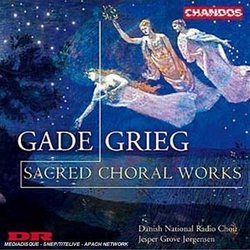| All Artists: Edvard Grieg, Niels Gade, Jesper Grove Jørgensen Title: Grieg & Gade Sacred Choral Works Members Wishing: 0 Total Copies: 0 Label: Chandos Release Date: 7/25/2000 Genres: Pop, Classical Styles: Vocal Pop, Opera & Classical Vocal, Chamber Music, Historical Periods, Early Music, Sacred & Religious Number of Discs: 1 SwapaCD Credits: 1 UPC: 095115976722 |
Search - Edvard Grieg, Niels Gade, Jesper Grove Jørgensen :: Grieg & Gade Sacred Choral Works
 | Edvard Grieg, Niels Gade, Jesper Grove Jørgensen Grieg & Gade Sacred Choral Works Genres: Pop, Classical Niels Gade belongs to the generation of composers before Grieg, and his religious output is much more convincing than that of his sometime protégé, displaying hardly any of that saccharine piety common in early 1... more » |
Larger Image |
CD Details
Synopsis
Amazon.com
Niels Gade belongs to the generation of composers before Grieg, and his religious output is much more convincing than that of his sometime protégé, displaying hardly any of that saccharine piety common in early 19th-century choral works. Indeed, as a body (and because Gade often writes for eight parts), it stands comparison with Schumann's glorious Doppelchörige Gesänge. Grieg's relationship with the church, however, was much more strained, and this explains the relatively small number of religious choral works in his output, and also the tone of professional beauty rather than devotion that they display. Having said that, though, they do span the composer's entire career and show his artistic development in miniature, from the academic fugue he wrote as a student to the highly individualized use of folk tunes in his final composition, Four Hymns. The beauty and accuracy of the Danish National Radio Choir's singing are almost frightening, until the silken persuasiveness of the sound seduces you into forgetting it. --Warwick Thompson



